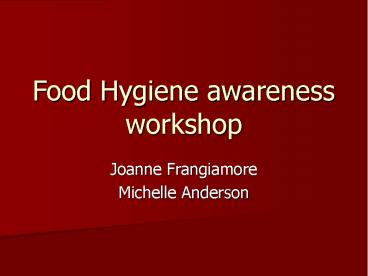Food Hygiene awareness workshop - PowerPoint PPT Presentation
Title:
Food Hygiene awareness workshop
Description:
Food Hygiene awareness workshop Joanne Frangiamore Michelle Anderson Hazards Physical Contamination Dirt and dust Fragments of shell/bone Fingernail Parts of ... – PowerPoint PPT presentation
Number of Views:966
Avg rating:3.0/5.0
Title: Food Hygiene awareness workshop
1
Food Hygiene awareness workshop
- Joanne Frangiamore
- Michelle Anderson
2
HazardsPhysical Contamination
- Dirt and dust
- Fragments of shell/bone
- Fingernail
- Parts of machinery
- String
- Broken glass
3
Chemical contamination
- Perfume
- Cleaning products
- Industrial chemicals
4
Biological contamination
- Yeast
- Bacteria
- Viruses
- Moulds
5
Allergen contamination
- Nuts
- Wheat
- Shell fish
- Lactose
6
Food Poisoning
- Bacterial contamination is the most common cause
of food poisoning.
7
Food Poisoning
- In 2007 92,000 reported cases in UK
- Food Standards Agency estimates that there are
more than 850,000 cases per year in the UK. - Most cases are not reported.
8
Food poisoning
- Certain types of food are more likely to cause
food poisoning than others High risk foods - These are ready to eats foods such as
- Rice
- Soft cheese
- Pate
- Meat and poultry
9
Ideal conditions for bacteria
- The ideal conditions for bacterial growth are
- Food ,moisture ,warmth and time
10
Danger Zone
- Keep foods safe by making sure they are not left
at room temperature.
11
Everyone is responsible!
- Everyone who works with food has a duty to make
sure it is safe and does not cause the customer
harm - The four main controls to reduce the risk of harm
are - Cross-contamination
- Cooking
- Chilling
- Cleaning
12
Cross contamination
- Contamination can occur at any time in food
preparation or service. - Cross contamination occurs when bacteria are
spread from one food to another. - Examples
- From hands to boards and onto food
- From cloths to equipment and onto food
- From foods dripping onto each other
13
Your Hands!
- Wash your hands regularly and properly to
prevent cross contamination. - Before entering a food prep area
- Between handling raw and high risk food
- After taking a break
- After going to the toilet
- After blowing your nose
- After carrying out cleaning jobs
- After handling waste.
14
Hand washing
- To wash your hands you will need
- Hot water
- Liquid soap
- Disposable roll
- Air dryer
15
Cross contamination
- Cloths are a major source of cross contamination
in food areas - Use disposable cloths/paper roll for cleaning
tasks - Keep raw and ready to eat foods apart where
possible store separately - Pests must be controlled as they can contaminate
food, spread disease and damage premises. - Keep all foods covered at all times
16
Cooking
- It is essential to cook food properly to kill
harmful bacteria - Cook, or reheat food to a minimum core
temperature of 75oc for two seconds - If holding food hot, the minimum core temperature
must not fall below 63oc
17
Chilling
- High risk foods or foods with a use by date need
to be kept chilled. - It is recommended to keep cold food at 5oc or
below - Chill hot food to 5oc or below as quickly as
possible - Frozen food should be stored at -18oc or colder
- Keep food out of the danger zone (5oc to 63oc)
- Defrost food in the fridge and ensure that the
product is fully defrosted before cooking
18
Cleaning
- Cleaning is the process of making something free
from dirt, grease and contamination. - Detergents remove dirt and dissolve grease but do
not kill bacteria eg fairy liquid - Disinfectants reduce bacteria to a safe level
- Sanitisers both clean and disinfect at the same
time eg. Dettox - All cleaning chemicals must be food safe
- Chemicals should be stored away from food
- When washing by hand, use a detergent first to
remove grease and dirt and then a disinfectant to
reduce bacteria to a safe level.
19
Cleaning
- To keep food safe adopt a clean as you go
approach - Disinfect boards and knives and food contact
surfaces between different food types - Hand contact surfaces need to be disinfected.
- Remember to change washing water once it is
dirty.































